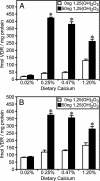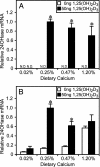Regulation of the murine renal vitamin D receptor by 1,25-dihydroxyvitamin D3 and calcium
- PMID: 12900504
- PMCID: PMC187834
- DOI: 10.1073/pnas.1633774100
Regulation of the murine renal vitamin D receptor by 1,25-dihydroxyvitamin D3 and calcium
Abstract
Renal vitamin D receptor (VDR) is required for 1,25-dihydroxyvitamin D3-[1,25(OH)2D3]-induced renal reabsorption of calcium and for 1,25(OH)2D3-induced 1,25(OH)2D3 24-hydroxylase. The long-term effect of vitamin D and dietary calcium on the expression of renal VDR was examined in the nonobese diabetic mouse. Vitamin D-deficient and vitamin D-replete mice were maintained on diets containing 0.02%, 0.25%, 0.47%, and 1.20% calcium with or without 50 ng of 1,25(OH)2D3 per day. Vitamin D-replete mice on a 1.20% calcium diet had renal VDR levels of 165 fmol/mg protein. Calcium restriction caused renal VDR levels to decrease to <30 fmol/mg protein in vitamin D-deficient mice and to approximately 80 fmol/mg protein in vitamin D-replete mice. When dietary calcium was present, 50 ng of 1,25(OH)2D3 elevated the VDR levels 2- to 10-fold, depending on vitamin D status and the level of calcium. In the absence of either vitamin D or calcium, the VDR mRNA was expressed at a basal level. 1,25(OH)2D3 supplementation caused relative VDR mRNA to increase 8- to 10-fold in the vitamin D-deficient mouse when dietary calcium was available. This increase was completely absent in the calcium-restricted mice. This in vivo study demonstrates that 1,25(OH)2D3 and calcium are both required for renal VDR mRNA expression above a basal level, furthering our understanding of the complex regulation of renal VDR by 1,25(OH)2D3 and calcium.
Figures




Similar articles
-
A High-Calcium and Phosphate Rescue Diet and VDR-Expressing Transgenes Normalize Serum Vitamin D Metabolite Profiles and Renal Cyp27b1 and Cyp24a1 Expression in VDR Null Mice.Endocrinology. 2015 Dec;156(12):4388-97. doi: 10.1210/en.2015-1664. Epub 2015 Oct 6. Endocrinology. 2015. PMID: 26441239 Free PMC article.
-
Temporal changes in tissue 1α,25-dihydroxyvitamin D3, vitamin D receptor target genes, and calcium and PTH levels after 1,25(OH)2D3 treatment in mice.Am J Physiol Endocrinol Metab. 2013 May 1;304(9):E977-89. doi: 10.1152/ajpendo.00489.2012. Epub 2013 Mar 12. Am J Physiol Endocrinol Metab. 2013. PMID: 23482451
-
1,25-Dihydroxyvitamin D3 up-regulates the renal vitamin D receptor through indirect gene activation and receptor stabilization.Arch Biochem Biophys. 2005 Jan 15;433(2):466-73. doi: 10.1016/j.abb.2004.10.001. Arch Biochem Biophys. 2005. PMID: 15581603
-
Vitamin D and type II sodium-dependent phosphate cotransporters.Contrib Nephrol. 2013;180:86-97. doi: 10.1159/000346786. Epub 2013 May 6. Contrib Nephrol. 2013. PMID: 23652552 Review.
-
The vitamin D hormone and its nuclear receptor: molecular actions and disease states.J Endocrinol. 1997 Sep;154 Suppl:S57-73. J Endocrinol. 1997. PMID: 9379138 Review.
Cited by
-
Impact of a 24 h feed withdrawal on active nutrient transport, intestinal morphology, and gene expression in the equine small and large intestine.Transl Anim Sci. 2023 Jan 28;9:txad003. doi: 10.1093/tas/txad003. eCollection 2025. Transl Anim Sci. 2023. PMID: 40041718 Free PMC article.
-
Intestinal resistance to 1,25 dihydroxyvitamin D in mice heterozygous for the vitamin D receptor knockout allele.Endocrinology. 2007 Mar;148(3):1396-402. doi: 10.1210/en.2006-1109. Epub 2006 Nov 16. Endocrinology. 2007. PMID: 17110426 Free PMC article.
-
Effects of ultraviolet irradiation with a LED device on bone metabolism associated with vitamin D deficiency in senescence-accelerated mouse P6.Heliyon. 2020 Feb 28;6(2):e03499. doi: 10.1016/j.heliyon.2020.e03499. eCollection 2020 Feb. Heliyon. 2020. PMID: 32140604 Free PMC article.
-
Aligning the Paradoxical Role of Vitamin D in Gastrointestinal Immunity.Trends Endocrinol Metab. 2019 Jul;30(7):459-466. doi: 10.1016/j.tem.2019.04.005. Epub 2019 May 20. Trends Endocrinol Metab. 2019. PMID: 31122825 Free PMC article. Review.
-
Ablation of the Stimulatory G Protein α-Subunit in Renal Proximal Tubules Leads to Parathyroid Hormone-Resistance With Increased Renal Cyp24a1 mRNA Abundance and Reduced Serum 1,25-Dihydroxyvitamin D.Endocrinology. 2016 Feb;157(2):497-507. doi: 10.1210/en.2015-1639. Epub 2015 Dec 15. Endocrinology. 2016. PMID: 26671181 Free PMC article.
References
-
- Haussler, M. R., Whitfield, G. K., Haussler, C. A., Hsieh, J. C., Thompson, P. D., Selznick, S. H., Dominguez, C. E. & Jurutka, P. W. (1998) J. Bone Miner. Res. 13, 325–349. - PubMed
-
- Halloran, B. P. & DeLuca, H. F. (1981) J. Biol. Chem. 256, 7338–7342. - PubMed
-
- Dokoh, S., Donaldson, C. A. & Haussler, M. R. (1984) Cancer Res. 44, 2103–2109. - PubMed
-
- Ross, T. K., Darwish, H. M. & DeLuca, H. F. (1994) in Vitamins and Hormones, ed. Litwack, G. (Academic, San Diego), Vol. 49, pp. 281–326. - PubMed
-
- Costa, E. M., Hirst, M. A. & Feldman, D. (1985) Endocrinology 117, 2203–2210. - PubMed
Publication types
MeSH terms
Substances
LinkOut - more resources
Full Text Sources
Medical

